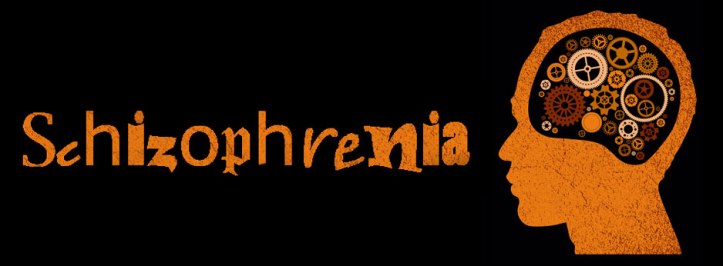
Note: this post needs work; I don’t even start rapping until halfway through (right after the graphic that looks like a heart monitor)… work in progress. Construction zone. Watch your head and mind your step. I’ll catch you in the middle.
The Prevalance Rate for schizophrenia is approximately 1.1% of the population over the age of 18 (source: NIMH) or, in other words, at any one time as many as 51 million people worldwide suffer from schizophrenia, including;
- 6 to 12 million people in China (a rough estimate based on the population)
- 4.3 to 8.7 million people in India (a rough estimate based on the population)
- 2.2 million people in USA
- 285,000 people in Australia
- Over 280,000 people in Canada
- Over 250,000 diagnosed cases in Britain
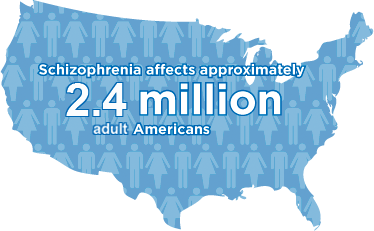
Schizophrenia is a chronic brain disorder that affects approximately 2.4 million Americans and 1% of the world’s population. Studies show that schizophrenia may be caused by an imbalance of chemicals in the brain.
At this time, no one knows exactly what causes the condition or why schizophrenia affects some people and not others. Scientists believe that schizophrenia, like many other conditions, may result from a combination of genetic and environmental factors.
Schizophrenia Myths
-
‘Schizophrenia means someone has a split personality’
One error is that schizophrenia means that people have multiple or split personalities. This is not the case. The mistake may come from the fact that the name ‘schizophrenia’ comes from two Greek words meaning ‘split’ and ‘mind’.
-
‘Schizophrenia causes people to be violent’
People with a diagnosis of schizophrenia are more likely to be a danger to themselves than to other people. Unfortunately, some people with the illness may become violent because of delusional beliefs or the use of drugs or alcohol.Because these incidents can be shocking, the media often reports them in a way which emphasizes the mental health aspects. This can create fear and stigma in the general public.
Only a small minority of people with the illness may become violent, much in the same way as a small minority of the general public may become violent.
Schizophrenia Symptoms
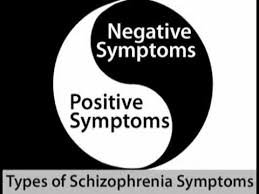
Positive symptoms: Extra feelings or behaviors that are usually not present, such as:
- Distortions in thoughts or beliefs (delusions)
- Hearing, seeing, tasting, feeling, or smelling things that others do not experience (hallucinations)
- Disorganized speech and behavior
Negative symptoms: A lack of behaviors or feelings that usually are present, such as:
- Losing interest in everyday activities, like bathing, grooming, or getting dressed
- Feeling out of touch with other people, family, or friends
- Lack of feeling or emotion (apathy)
- Having little emotion or inappropriate feelings in certain situations
- Having less ability to experience pleasure
The Course of Schizophrenia
- Early intervention and early use of new medications lead to better medical outcomes for the individual
- The earlier someone with schizophrenia is diagnosed and stabilized on treatment, the better the long-term prognosis for their illness
- Teen suicide is a growing problem — and teens with schizophrenia have approximately a 50% risk of attempted suicide
- In rare instances, children as young as five can develop schizophrenia.
Anti-psychotic medications are the generally recommended treatment for schizophrenia. If medication for schizophrenia is discontinued, the relapse rate is about 80 percent within 2 years. With continued drug treatment, only about 40 percent of recovered patients will suffer relapses.( Source: NIMH)
Wide variation occurs in the course of schizophrenia. Some people have psychotic episodes of illness lasting weeks or months with full remission of their symptoms between each episode; others have a fluctuating course in which symptoms are continuous but rise and fall in intensity; others have relatively little variation in the symptoms of their illness over time.
At one end of the spectrum, the person has a single psychotic episode of schizophrenia followed by complete recovery; at the other end of the spectrum is a course in which the illness never abates and debilitating effects increase. (source: Openthedoors).
Recent research increasingly shows that the disease process of schizophrenia gradually and significantly damages the brain of the person, and that earlier treatments (medications and other therapies) seem to result in less damage over time (source: UCLA NeuroImaging Lab).
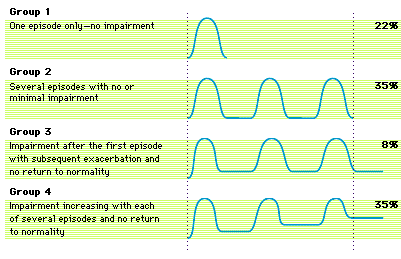
Hi. Uttley here. About time I chimed in to add some flavor to this so-far dry-ass Sz factsheet I’m cobbling together. I’ve been clicking around to various sites, snatching bits of info from hither and yon, with the compound intent of educating myself and others.
If you check out the outstandingly attractive graphic above with the four groups, which I cribbed from schizophrenia.com, you’ll see that Group 1 (22% of Sz sufferers) is characterized by one episode of psychosis, and no cognitive impairment. That’s my group.
I mean, having ‘voices’ to whatever extent they are manifesting (depending on how faithful I’ve been with my meds) does interfere with my ability to focus and reason, but I don’t believe that the ‘disease process’ of Sz has significantly damaged my brain as yet.
But yeah, as I was saying, this exercise in info-gathering is as much for myself as it is for anyone who might access this post once I’m done playing with it. I don’t know much about Sz. When I was diagnosed, I went to Amazon and ordered a half-dozen books about it: a few memoirs by sufferers, and one fat manual purporting to be “The Indispensable Guide To Today’s Most Misunderstood Illness”…
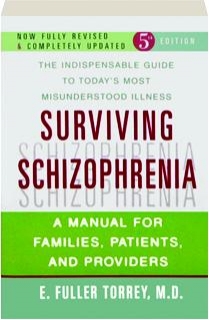
Never even cracked the cover. I dunno whether I am afraid to know or too lazy to do research or what. Not one of the handful of psychiatrists who have handled my case since I was diagnosed almost nine years ago has shed any light on the workings of Sz for me. They have been mere prescribing authorities. Every one of them has spent the entirety of every 15-minute session with me typing on a laptop. They haven’t even asked me many questions about my year-long episode or current symptoms.
The head shrinkers do seem curious as to any side-effects of the meds, but that’s about it. I would really love to sit with a Sz expert who could say, like, this is what we know about Sz, this is how it appears to be manifesting in your case, and here’s what we’re going to do about that. That would be grand. No such luck. Just tap-tap-tap on the laptop, and “Your next month of meds will be available to you at your pharmacy.”
Yeah, so I never opened the book, Surviving Schizophrenia. But I’m going to right now. I’ve had my fill of wading through the drug advertisements and atrocious writing of different websites for now. I’m on a roll here, though, so let’s see what an actual, supposedly authoritative, flesh-and-bones book has to say on the matter.
“The person observed talking to himself or to inanimate objects… the sine qua non for schizophrenia… the image of talking to oneself is the image evoked in our minds when the term ‘crazy’ or ‘mad’ is used.”
Hmm. Oh, that reminds me. I want to embed the #IAmWhole youtube vid. No time like the present.
I am whole. I don’t know what it means, quite, but I like it. A lot. Don’t you? Just the way the kid says ‘togever’ is awesome…
Anyway, back to the book.
“One simple form of a delusion is the conviction that random events going on around the person all relate in a direct way to him or her.”
“Reasoning with people about their delusions is like trying to bail out the ocean with a bucket.”
“In many cases the delusions become more complex and integrated… the person becomes convinced that he/she is being controlled by other persons, manipulated…”
“…grandiose delusions are quite common… a belief by the person that he/she is Jesus Christ, the Virgin Mary, the Preisdent, or some other exalted or important person.”
“Another variant is the delusional belief that one’s thoughts are radiating out of one’s head … this is called thought broadcasting and is considered to be an almost certain indication of schizophrenia.”
“Auditory hallucinations are by far the most common form of hallucination in schizophrenia…In the vast majority of cases, the voices are unpleasant. They are often accusatory, reviling the victims… Often they curse them…”
Yep yep. All of that and a bag of chips. Hey, this book ain’t half bad. Here’s a graphic I really wish I could click on, scoop the url of, upload into wordpress, and plop into this post. Instead I’ll have to type it all in. *sigh* The lengths I’ll go to in order to put together a decent blogpost…
THE BRAIN WITH SCHIZOPHRENIA:
A SUMMARY OF FINDINGS RELATED TO ITS CAUSE
- The disease is familial.
- There are neurochemical changes.
- There are structural and neuropathological changes.
- There are neuropsychological deficits.
- There are neurological abnormalities.
- There are electrical abnormalities.
- There are immunological and inflammatory abnormalities.
- Individuals with schizophrenia are born disproportionately in the winter and spring.
- Individuals with schizophrenia are born and/or raised disproportionately in urban areas.
- Other abnormalities include pregnancy and birth complications, minor physical anomalies, and an absence of rheumatoid arthritis.
Hey, that’s fabulous! I’m not going to develop arthritis! I just knew this Sz business was good for something. And here I thought the only benefits were, like, making me more sympathetic and compassionate regarding the struggles of others, and showing me something that I want real bad. Haha. That’s what my book The Boon is all about – the fact that Sz has shown me (a person who rarely feels much desire) what I really want. Drumroll. Which is not to have Sz. Budumpum tsh!
Ooh. Here’s a whole section on how Sz is portrayed in movies and literature and the problem of stigma.
“People with schizophrenia and their families have to live with an extraordinary amount of stigma. Schizophrenia is the modern-day equivalent of leprosy, and in the general population the level of ignorance about schizophrenia is appalling… schizophrenia is associated with violent behavior in the minds of the public. .. the association between schizophrenia and violent behavior appears to be growing stronger.”
“One of the major reasons why services and research for schizophrenia have been so neglected is that most people do not understand this disease… What you can do as an advocate: …Organize an education campaign… studies have shown that the more people understand about schizophrenia, the less likely they are to stigmatize persons who are affected.”
Roger that. Okay E. Fuller Torrey, M.D. – thanks for the decent treatise on my… what do you even call it? Condition? Disorder? Illness? Sickness? Disease? Who knows.
On my way out of the book, I found an appendix written by one Judy Miller, entitled Useful Web sites on Schizophrenia. Gotta love how Web is capitalized and there’s a space between it ans sites, which is not capitalized. That’s some good editing right there. Anyway…
- schizophrenia.com
- mentalhealth.com
- chovil.com
- psychlaws.org
- nami.org
- schizophrenia.ca
- bcss.org
- narsad.org
- healthscout.com
- worstpills.com
- schizophreniaforum.org
Aaand I’m maxed out on the research tip for now. At about 1,800 words. (Fun fact: the average word count of top-ranking content [in Google] is between 1,140-1,285 words; source: SearchMetrics.)
To be continued…
[…] Just left off working on a largish post about Sz. Research is taxing. Time to unwind with a little #MicroblogMondays post. Mel, The Stirrup Queen, […]
LikeLike
Very informative. Thank you!
LikeLiked by 1 person
[…] Comments & likes on “What is SZ?” and engagement with similar blog posts and relevant Twitter and Facebook […]
LikeLike
[…] my goal of fighting M.I. stigma… When I was researching Sz for another recent post – “What is Sz?” – I found evidence that the wrong-headed association of Sz with violent behavior is actually […]
LikeLike
The rheumatoid arthritis bit is interesting from a biomedical perspective.. I wonder why this is? Perhaps there are underlying similarities, as both are likely to be responses to inflammation. And absence of RA makes you less likely to have atherosclerosis, which is a good thing as it is one of the risk factors for a heart attack.
I’m reminded that nothing is ever purely a bad thing, as it is all ying-yang in the end. Another example of this is sickle cell disease, which is a genetic disorder that makes one immune to malaria. Not entirely sure which would be worse, but malaria is still one of the world’s leading causes of preventable mortality so it is a useful protective effect for anybody who lives in the tropics.
LikeLike
Wow.. long comprehensive post. I’ve been meaning to devote some more time to learning more of the stats surrounding sz. I feel I should probably know a little bit more about this crazy diagnosis I have been handed. I’m not sure if you already saw it, but I published part 2 and 3 of my “why saying I hear voices is woefully inadequate..” and wondered if you had any thoughts or comments 🙂
LikeLiked by 1 person
Very good post on SZ, helpful to me in understanding my patients and or friends, well done 💙💛🙏🏼🦋
LikeLiked by 1 person
So pleased. Thanks.
LikeLike